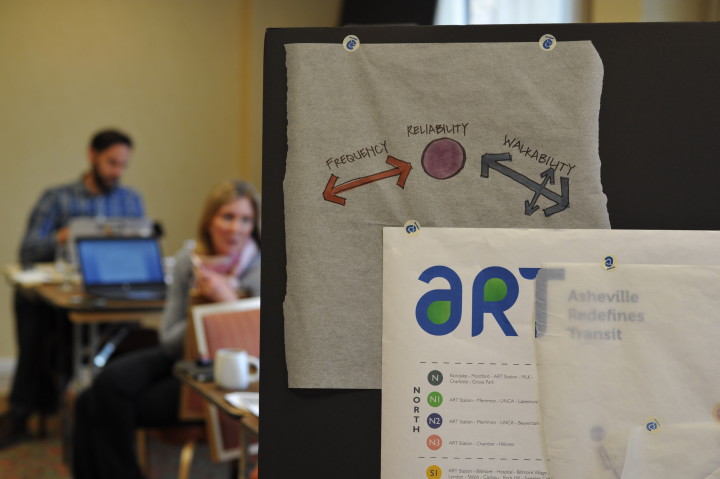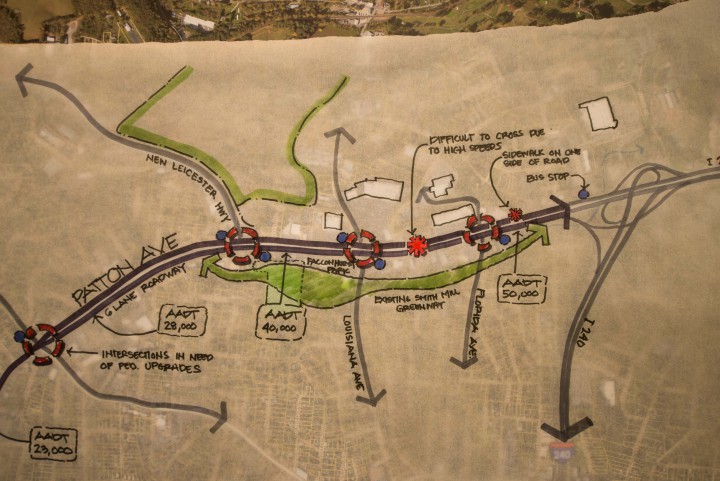For a city’s multimodal transportation system to be a success, moving from point A to point B should not only be safe and efficient, but there should be options for those who aren’t traveling via automobile.
The city of Asheville hosted the Asheville in Motion design charrette this week, with a summary open house being presented Sat. morning from 10 a.m. to noon. The charrette brings together city officials and Raleigh-based design firm Kimley-Horn, Nelson\Nygaard Consulting Associates, Inc., Toole Design Group, Accessible Design for the Blind, and Kostelec Planning, LLC.
All are tasked with the city’s goal to “create an effective and progressive plan that encourages health-oriented and sustainable transportation, reduce barriers to access transportation, and connect residents and visitors with the places they want and need to go with improved safety, efficiency, and accessibility.” The brainstorming sessions this week are public-oriented, and follow the guidelines of a charrette: they are focused on design and planning effort in a short amount of time.

Karl Sutter of Kimley-Horn explained that the broad, citywide study conducted was part of an information gathering campaign, which was then presented in an informal way to the public this week through visual aids at the charrette. The study encompassed three things:
1. Taking a broad, overall look at the transportation system’s maps for the city. What can be improved? Are there areas that are lacking in transportation routes?
2. Taking a look at eight example corridor types in Asheville- these are roadways that you might find in locations throughout the city. The charrette created examples of what could happen there, easing traffic, providing more pedestrian space, more bike lanes, or a combination of these.
3. Developing a methodology approach based on empirical data. Sutter said this will allow the city to make fundamental decisions regarding how transportation dollars are allocated and spent. He stressed that this should reflect the values that are expressed for the city of Asheville, which have been expressed to Kimley-Horn through the public and city leaders.
Data gathered suggests that the values of Asheville reflect a broader choice of how to get around, especially for those not wanting to drive a car.
“Solutions presented here, many of them are about having more options,” said Mariate Echeverry, transportation planning manager for the city of Asheville. “If you want to drive, you drive, but if you decide you don’t want to own a car, or can’t afford one, we want you to be able to have other options.”
These options can be as simple as installing a sidewalk so people can walk to work, or planning a future bus route on a heavily trafficked area. Later this year, a draft plan will be submitted for public comment, and the full mobility plan is scheduled to be made available to the community this fall.
“The means by which people move around affects citizens and tourists that come here,” said Sutter. “It should do so in a way that continues to make this a very attractive place to visit, but equally, if not more important, an attractive place to live.”





Before you comment
The comments section is here to provide a platform for civil dialogue on the issues we face together as a local community. Xpress is committed to offering this platform for all voices, but when the tone of the discussion gets nasty or strays off topic, we believe many people choose not to participate. Xpress editors are determined to moderate comments to ensure a constructive interchange is maintained. All comments judged not to be in keeping with the spirit of civil discourse will be removed and repeat violators will be banned. See here for our terms of service. Thank you for being part of this effort to promote respectful discussion.